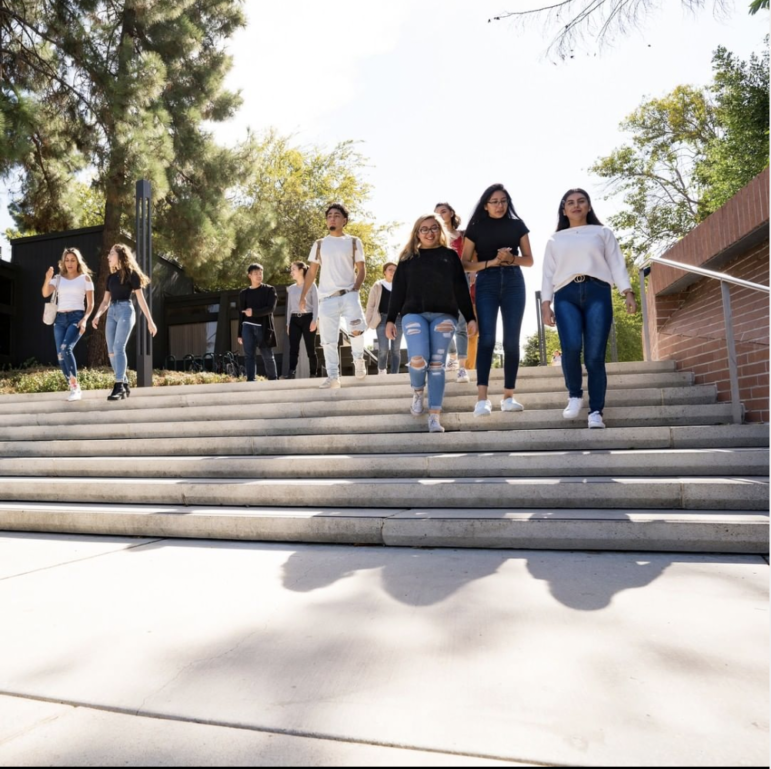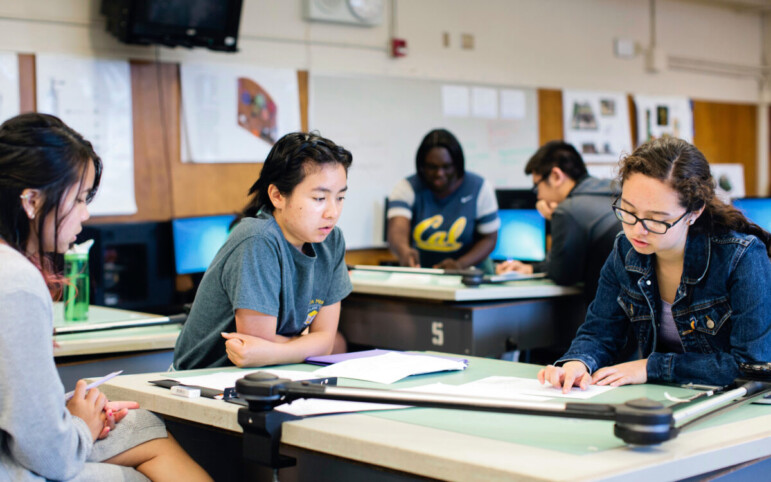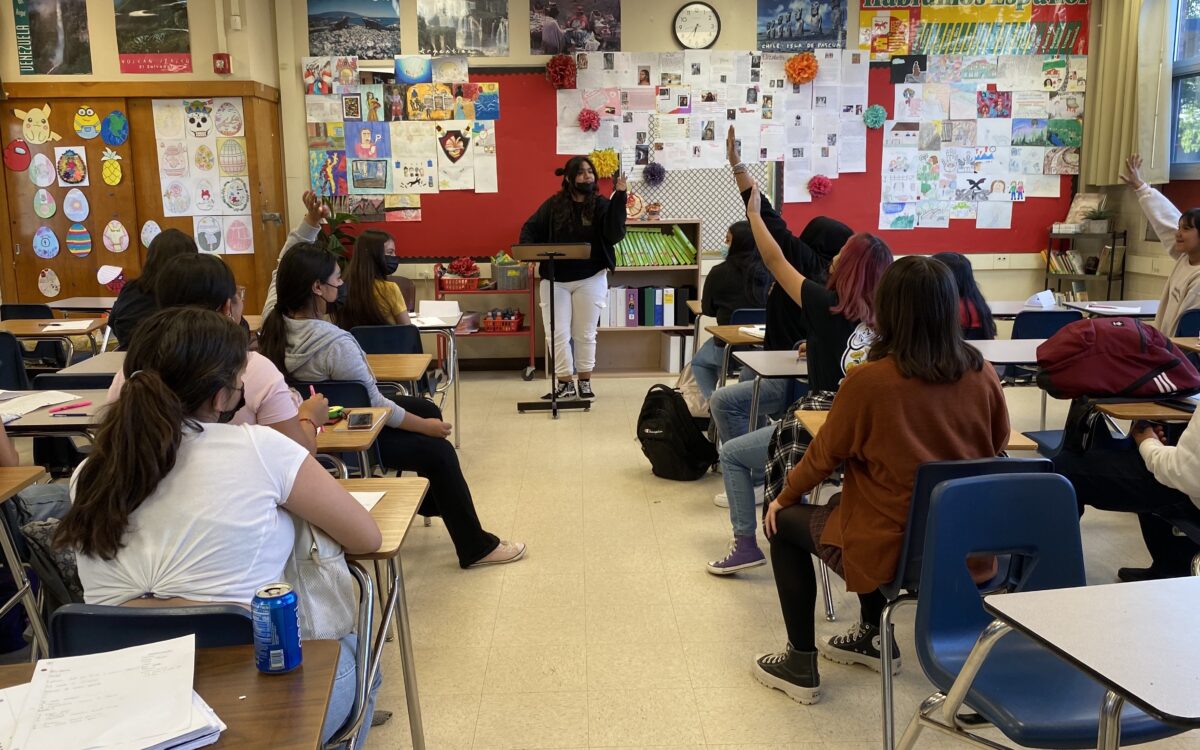An increasing number of students in California are graduating from high school with college credits under their belt. The main three ways to do this are through Advanced Placement courses, dual enrollment or International Baccalaureate.
This guide aims to give high school students and their families an overview of college-level coursework in California for young students and how it could affect them in college and their career.

- What is the purpose of earning college credit early?
The main reason students take college-level coursework during high school (and sometimes middle school) is to get a jump on college credits.
Even a handful of college credits earned in high school can save valuable time and tuition dollars later on. This means potentially earning a bachelor’s degree much faster, enabling students to begin their careers and start earning sooner.
Many dual enrollment programs will enable students to graduate with a full associate’s degree as a high school student. That allows students to begin college as juniors. The rise of the community college baccalaureate has opened up the possibility of graduating from college one year after high school graduation. Students at McFarland High can graduate with a bachelor’s degree in industrial automation from Bakersfield College just one year after high school.
Coming into college with credit could also give students flexibility to take on other opportunities they might not otherwise have had time for, such as an internship or study abroad program.
Some students take these courses to burnish their college applications. Taking college-level courses demonstrates to selective college admissions offices that a student is ready for the intellectual rigor of college. Some college-level courses taken through high school are given extra weight, which can boost a student’s grade point average and class ranking.
Many advocates see these courses as a way to encourage college attendance among students who may not be college-bound, such as first-generation college students. Exposure to college-level coursework can help students develop the study habits and critical thinking key for success in college.
“It helps them to build confidence, and I think that that’s really key,” said Michelle Whittington, Associate Vice Chancellor and Interim Director of Undergraduate Admissions for UC Santa Cruz. “Because sometimes students, for many different reasons, aren’t sure if they’re college material.”
- What is dual enrollment?
This simply means that a high school student is enrolled in a college course. Most dually enrolled students in California take courses through local community colleges, though some four-year colleges and universities also allow high school students to enroll.
In 2015, California made an effort to expand dual enrollment options to students who may not be high-achievers or who are historically underrepresented in college. College and Career Access Pathways (CCAP) makes it easier for students to take courses on their high school campus, either during the regular school day or after school.
Many offerings count toward general education credits required for a bachelor’s degree. However, many dual enrollment programs in California also include career training in areas, such as health care, computer technology or education. This aims to give students entry into a career after high school or a headstart in college.
Dual enrollment, because it is an actual college course, does not count toward that minimum amount of time students are required to spend each day in high school. That limits the number of courses a high school student can take. Students at early college and middle college high schools are exempt from this, enabling students to enroll in more college courses.
- What is Advanced Placement?
Since the 1950s, the nonprofit College Board has operated college-level curriculum and exams for high school students. The offerings today include 38 Advanced Placement (AP) courses that typically cover the span of introductory-level liberal arts courses, including art, history, math, science, economics, political science, language and literature courses.
Students enrolled in Advanced Placement courses aiming for college credit take a final course exam in May. Students are graded on a scale of 1 to 5. A 3 or higher is considered a passing score for which many colleges grant credit. Pass rates last year varied from 48.6% in U.S. Government and Politics to 86.6% in 2-D Art and Design.
- What is the International Baccalaureate?
As its name suggests, the International Baccalaureate is a program offered and accepted in countries all over the world. Its curriculum ranges from early education through high school.
The capstone is the IB Diploma Programme for upperclassmen in high school. One requirement is passing courses in six subject areas that include art, science, language, literature, mathematics and social science. Passing requires a final examination, and exam scores are what may earn a student college credit. The highest score on an IB test is 7, and 5 is considered a passing grade.
- How does a student earn college credit?
Students in dual enrollment courses receive credit the same way any other college student does: by completing the coursework, which may include assignments, quizzes and tests. Passing a course requires at least a C.
However, credit for AP or IB courses hinges entirely on how well a student performs on a single — and what some students see as high-pressure — exam. Some AP students pass their coursework but fail the exam, receiving no college credit.

- Which is the best option?
Admissions officers generally don’t prefer one kind of course.
“The key for us is that students are challenging themselves within the opportunities they have available,” said Whittington.
A student whose school offers little or no college-level courses won’t be disqualified for what they couldn’t take.
Scheduling is a consideration. Dual enrollment courses aren’t always offered during the regular school day, which can make it tough for students with after school commitments, such as sports, a job or caregiving duties. An AP or IB course might be offered during a time that conflicts with a student’s favorite elective.
Admissions officers consider this, too. The measure of a student isn’t simply their academics, but their passions, their extracurriculars and the unique challenges they face in life, said Whittington.
Some students like the intensity of test-centric AP courses. Others prefer dual enrollment courses, so that their college credit is not completely determined by one test in May.
- Do I need to come into college with credit?
An increasing emphasis on getting college credit early and graduating from college early might worry those who are entering college with no credits.
“I never want the student to worry,” Whittington said. “They can be a senior or junior and not have any dual credit and that’s OK.”
- Will my college or university accept this credit?
That depends largely on which college or university a student plans to attend and what they plan to major in. The only way to know for sure is to reach out to an individual college or university.
But for the vast majority of California students, the answer is yes. Community colleges, CSUs and UCs all accept passing AP scores of 3 and better, IB scores and dual enrollment college credit. These are the schools that approximately 85% of college-going California high school students attend. Most out-of-state schools and many private institutions give credit for these scores or courses as well.
Some selective universities cap the credit obtained ahead of their undergraduate education. Stanford, for example, caps credit for incoming freshmen at the equivalent of one year. A few highly selective universities, such Caltech, do not accept any of these programs’ credit at all. However, these elite schools prefer candidates who have taken the most rigorous coursework offered by their high school, which are typically dual enrollment, AP or IB courses.
- Will this class count for high school credit?
This depends on the high school. Generally, students taking AP or IB courses receive credit in high school, and it counts toward their GPA. Many dual enrollment courses — especially those taken during the regular school day — count toward high school credit and grades.
- How will these courses affect my GPA?
Many high schools will weigh college-level courses with an extra point. Even if a high school doesn’t, a college or university might. UC will award an extra point up to eight courses for AP, IB or dual enrollment courses. CSU will do the same.
- Who teaches the course?
Typically, high school teachers teach AP or IB courses.
Dual enrollment courses in California work differently. These courses must be taught by instructors who meet the minimum requirements in their field of study set by the state. Typically, this is a master’s degree in that particular discipline, though in career and technical education, several years of experience in the field of study may be sufficient.
Many college professors, particularly part-time adjunct faculty members, teach these courses. Some high school teachers may be qualified to teach these programs, but many do not.
Expanding the pool of instructors will require “upskilling” high school teachers. There are efforts in the Central Valley to support high school English and math teachers getting a master’s degree.

- Can students who are homeschooled or studying independently get college credit?
Students can self-study for AP exams, which makes AP a good option for those who are homeschooled or otherwise independently studying.
IB is currently rolling out an option for students to take courses toward the IB Diploma Programme online, which opens the courses up to students who are not enrolled in an IB-certified school.
Whittington said UC Scout is an underutilized option for high school students who can’t find the high school class they’re looking for in their own local schools. UC Scout offers remote options for A-G options that are free to public school students. It includes AP courses.
- How much does it cost?
Dual enrollment courses taken through a high school are generally free to students: covering the cost of tuition, fees and even books and other materials required for courses.
The College Board currently charges $97 per AP test and reduces the fees for low-income students to $53. School districts in California may also use local control funds to pay test fees for its students.
IB charges schools $119 per exam, and schools can choose whether to pass those fees along to students.
- What is available for me?
Offerings vary widely by region. The best way to learn about options is to reach out to a high school counselor or a local college or university.
- Who is eligible to take these courses?
Theoretically, any high school student who is ready to do the hard work that comes with college-level courses should be eligible. There are options for students in continuation schools, juvenile detention and adult schools.
High school counselors may dissuade students from taking coursework if they feel a student is not academically prepared or emotionally mature. At some schools, college-level courses may be reserved for students who are on an honors track and college-bound.
The expansion of dual enrollment courses on high school campuses is intended to open up college-level coursework to students beyond high achievers.
In practice, some dual enrollment courses or pathways can be extremely competitive, and some types of students may be dissuaded from taking these courses. An EdSource analysis found that Black and Latino students were underrepresented in dual enrollment courses in most college districts.
Some high schools reserve slots for students who do not have high GPAs. Middle College High School in San Bernardino keeps 80% of its slots available to students with GPAs between 1.89 and 3.49. Some schools set minimum requirements and hold lotteries for all eligible students to keep access equitable.
